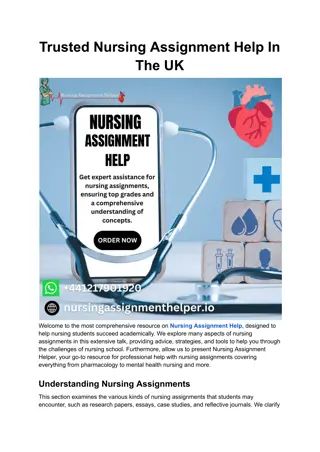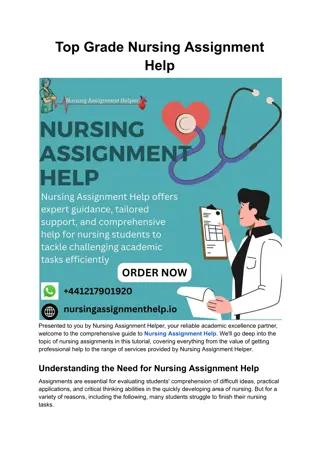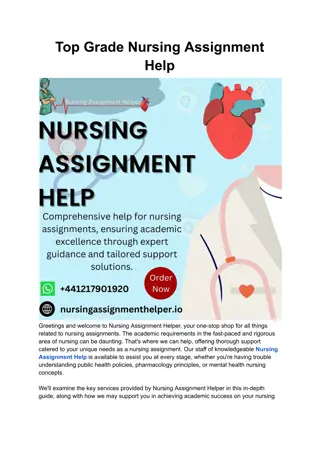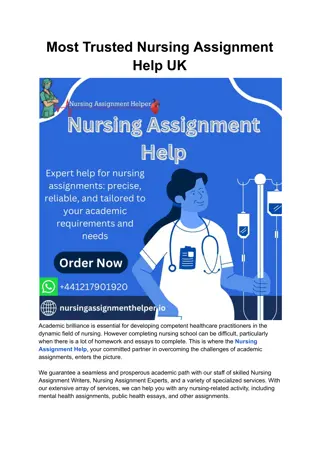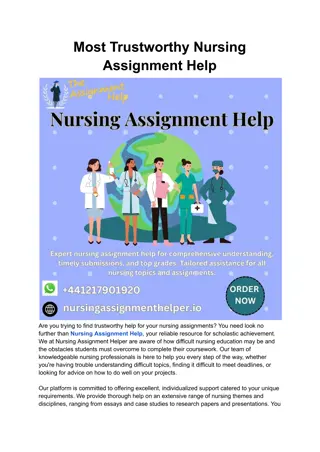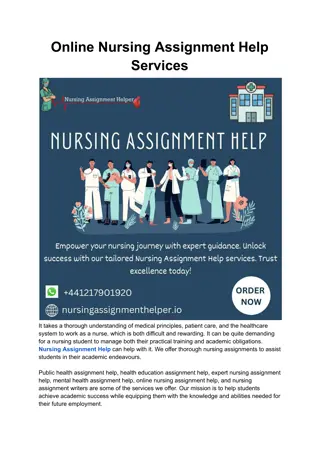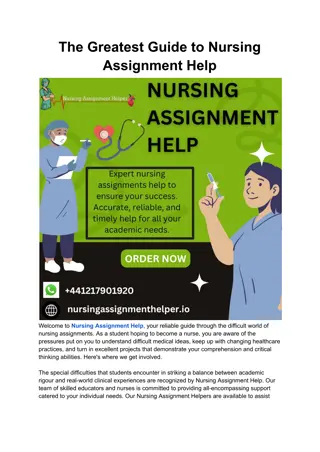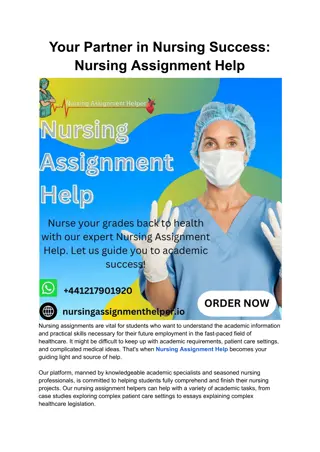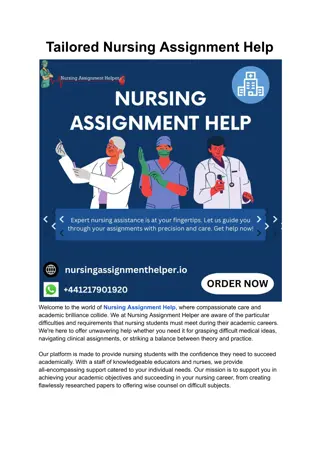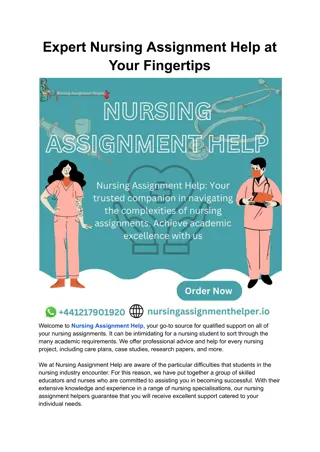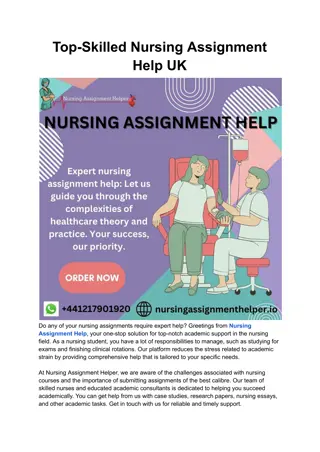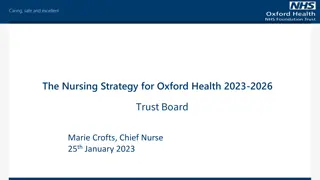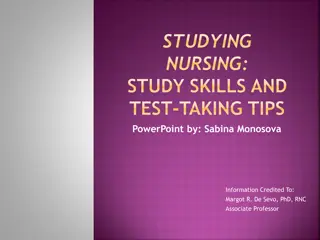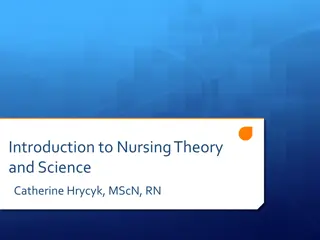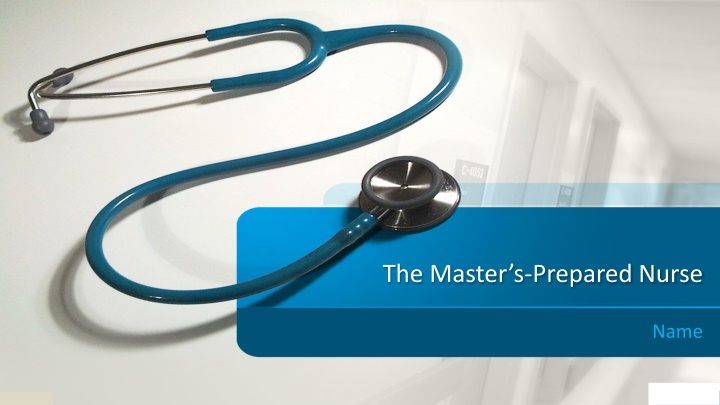
Nurse Executive Roles, Qualifications, and Competencies in Healthcare Settings
Explore the crucial role of nurse executives in providing high-quality patient care, including their qualifications, competencies, and key responsibilities within healthcare organizations. Learn how Master's-prepared nurses equipped with AACN Essentials lead change and promote health in various settings.
Download Presentation

Please find below an Image/Link to download the presentation.
The content on the website is provided AS IS for your information and personal use only. It may not be sold, licensed, or shared on other websites without obtaining consent from the author. If you encounter any issues during the download, it is possible that the publisher has removed the file from their server.
You are allowed to download the files provided on this website for personal or commercial use, subject to the condition that they are used lawfully. All files are the property of their respective owners.
The content on the website is provided AS IS for your information and personal use only. It may not be sold, licensed, or shared on other websites without obtaining consent from the author.
E N D
Presentation Transcript
Role Selected: Nurse Executive Nurse executives play an increasingly important role in providing high-quality, safe patient care. Nurse executives Provide direction and guidance Foster open discussions about quality Share outcomes and interpret data Role-model appropriate behaviors Provide critical thinking within the organization (L anaigh & Hughes, 2016)
Qualifications: Nurse Executive Senior nurse leaders who Possess advanced nursing education Have acquired management experience Function effectively in a healthcare organization Take responsibility for shared governance Work not only in patient care, but take an organization-wide, systemic view (Woten, 2015)
Competencies: Nurse Executive Nurse Executives must have these skills Leadership Professionalism Business Knowledge of healthcare environment Communication (Woten, 2015)
Roles of the Nurse Executive Chief Nursing Officer (CNO) Nurse Executive Director (NED) Chief Nurse Executive (CNE) Nurse Executive (in the U.K. Chief Operating Officer (COO) Chief Executive Officer (CEO) (Woten, 2015)
AACN Essentials and the Nurse Executive We must clearly articulate the unique substantive knowledge within the discipline of nursing that informs nursing administration practice and constitutes its distinctiveness. (Smith, 1993, p. 63) The AACN Essentials define the scope of all Master s- prepared nursing programs at colleges across America These Essentials ensure that Master s-prepared nurses are equipped with valuable knowledge and skills to lead change, promote health, and elevate care in various roles and settings. (AACN, 2011, p. 3)
The AACN Essentials I. Science & Humanities Background VII. VI. Health Policy & Advocacy Interprofessional Collaboration II. Organizational & Systems Leadership V. Informatics & Healthcare Technologies VIII. Clinical Prevention & Population Health III. Quality Improvement & Safety IV. Integrating Scholarship IX. Master s Level Nursing Practice (AACN, 2011)
AACN Essentials & the Nurse Executive I: Background from Sciences and Humanities Integrating clinical data Promoting evidence-based interventions Sharing information about patient experience to improve quality of care II: Organizational and Systems Leadership Consistency with organization s vision, mission & goals Shared governance, working with other healthcare personnel and executives (L anaigh & Hughes, 2016)
AACN Essentials & the Nurse Executive III: Quality Improvement & Safety Championing quality and patient safety and clinical governance at the board level Implements and oversees quality reporting processes Interpreting clinical data to determine best practices IV: Integrating Scholarship into Practice Expertise in health policy Incorporating evidence-based research Understanding of risk management Provides strategic, evidence-based advice (Woten, 2015; L anaigh & Hughes, 2016)
AACN Essentials & the Nurse Executive V: Informatics & Healthcare Technologies Providing nursing staff with technology needed for safe & effective care Using tools and technology to ensure organization runs successfully Using tools and technology for communication of healthcare information to patients, staff, executive, and others. VI: Health Policy & Advocacy Up-to-date with current issues affecting healthcare industry Networking with other nurse executives such as through AONE (American Organization for Nurse Executives) to understand current issues and channels for advocacy (Woten, 2015)
AACN Essentials & the Nurse Executive VII: Interprofessional Collaboration Working with other medical and non- medical professionals in interdisciplinary teams and committees Learning from other disciplines; informing other disciplines based on nursing theory & perspective VIII: Clinical Prevention & Population Health Incorporates evidence-based understanding based in nursing practice Work with diverse populations of patients, families, communities Assisting staff, providing leadership regarding cultural & population sensitivity (L anaigh & Hughes, 2016)
AACN Essentials & the Nurse Executive IX: The Master s-Prepared Nurse Influencing healthcare outcomes on a system-wide basis; mission & vision Integrating knowledge into practice Understanding of direct and indirect care components All 9 Essentials identified by the AACN apply to nurse executives in numerous ways (L anaigh & Hughes, 2016)
In Practice 1: Reducing Stress Essential IX: The Master s Prepared Nurse Many sources of stress on nurse executives Goal: identifying sources of resilience Resilience is increased by thorough preparation for the leadership role (Essential IX), as well as clinical work and collaboration with peers Engendering resilience requires appropriate role preparation (p. 3167) (Kelly, Lankshear, & Jones, 2016)
In Practice 2: Managing Data Essential V: Informatics and Technology Healthcare data can be a blessing or curse Nurse executives have access to more data sources than ever, along with tools to discover patterns and predict events, but this can be overwhelming and demand expertise Research recommends collaboration with other disciplines, such as nurse informaticists and clinical nurses (Essential VII) to discover useful, meaningful results and apply them. (Clancy & Reed, 2016)
In Practice 3: Improving Care Essential VII: Interprofessional Collaboration Case study: Chief Nurse Executives (CNEs) and Chief Nursing Officers (CNOs) collaborating in a University health network Goal: reducing hospital acquired infections (HAI) (Essential III), specifically infections not described in previous research. Researched and instituted 3-month trial (Essential IV). Nurse leaders mandated clinician attendance and negotiated patient care coverage empowering the entire team. (Quatrara et al., 2017)
Conclusions Master s-prepared nurse executives use the AACN Essentials for a positive organizational impact Benefits of prepared nursing leadership: Higher standards Improved quality of care Improved health consumer experience Improved health outcomes Need for Master s-qualified nursing executive will increase in today s healthcare climate (L anaigh & Hughes, 2016)
References American Association of Colleges of Nursing. (2011). The essentials of Master s education in nursing. Retrieved from http://www.aacn.nche.edu/education- resources/MastersEssentials11.pdf Clancy, T. R., & Reed, L. (2016). Big data, big challenges: Implications for chief nurse executives. The Journal of Nursing Administration, 46(3), 113-115. doi:10.1097/NNA.0000000000000307 Kelly, D., Lankshear, A., & Jones, A. (2016). Stress and resilience in a post-Francis world - A qualitative study of executive nurse directors. Journal of Advanced Nursing, 72(12), 3160-3168. doi:10.1111/jan.13086 L anaigh, P. ., & Hughes, F. (2016). The nurse executive role in quality and high performing health services. Journal of Nursing Management, 24(1), 132-136. doi:10.1111/jonm.12290 Quatrara, B., Rea, K., Wilkins, K., & Facteau, L. (2017). Partnering to improve outcomes: The nurse executive and the clinical nurse specialist. Nurse Leader, 15(1), 61-64. doi:10.1016/j.mnl.2016.08.011 Smith, M. C. (1993), The contribution of nursing theory to nursing administration practice. Image: the Journal of Nursing Scholarship, 25, 63 68. doi: 10.1111/j.1547-5069.1993.tb00755.x Woten, M. B. (2015). Nurse Executive Role (The Joint Commission, 2015). CINAHL Nursing Guide.




